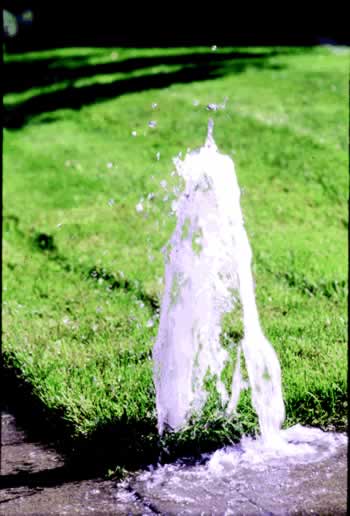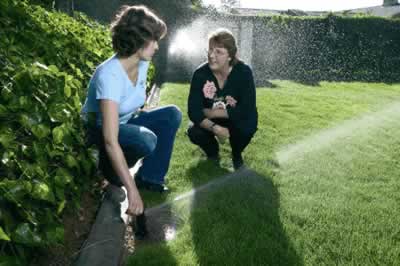Irrigation Maintenance
Monthly Maintenance
-
Once a month run your system in manual mode to check for leaks or breaks. This helps protect against plant loss and offers a simple way to conserve water. Also look for broken or tilted sprinkler heads, rotors stuck in place, misting (indicates water pressure is too high), uneven water coverage due to head spacing (water sprayed from each sprinkler head should reach adjacent sprinkler heads), heads not at grade (too high or too low), mismatched sprinkler heads and nozzles (prevents even precipitation rates), spray patterns blocked by plants, clogged nozzles or drip emitters, clogged filters, leaking or separated drip lines or missing emitters.
 A broken head wastes water and will create brown spots in the lawn.
A broken head wastes water and will create brown spots in the lawn.
Flushing the system
-
If sprinkler heads or drip emitters become clogged, they will need to be flushed. Sprinkler systems: remove individual nozzles from sprinklers. Turn system on for a few minutes until a clean, solid stream of water flows from each sprinkler head. Turn system off. Check nozzles before replacing to be sure they are not clogged. Clean and replace any screens and clogged nozzles. Turn system on and check for proper operation.
-
Drip systems: Remove end caps from drip lines. Turn system on for a few minutes until a clean, solid stream of water flows from the end of the line(s). Turn system off. Replace end caps. Turn system on and check for proper operation. Replace emitters that are not functioning properly. Clean the drip filters and replace if damaged.
Adjusting sprinklers
Adjust sprinkler heads as much as possible so that water from each head just reaches the adjacent head(s). This overlapping pattern improves water coverage and can reduce dry and wet spot problems.
 Check the arc of the rotors and impact sprinklers to ensure that they are not overspraying onto driveways and walks.
Check the arc of the rotors and impact sprinklers to ensure that they are not overspraying onto driveways and walks.
Hardware compatibility
Determine if sprinkler heads within each valve circuit match (not all brands and models are interchangeable and/or compatible). Be sure that sprinkler heads within each valve or zone have the same precipitation rate for even coverage.
Additionally, the radius of nozzles (the distance the nozzle is designed to spray water) should match actual spacing of sprinkler heads to achieve head-to-head coverage.
Spigots
Check the spigot for leaks. If the spigot is leaking around the stem when the water is turned on, it can usually be fixed by tightening the bonnet or packing nut behind the handle. If it still leaks after tightening, the washer on the end of the valve stem needs to be replaced.
Dry or wet spots
If dry or soft wet spots are present in the landscape, make adjustments to improve the irrigation system inefficiencies.
Just Right
If the soil is dry or slightly damp on the surface and the lawn springs back when walked on, the schedule should not be modified because the station’s irrigation schedule is on target.
Irrigation Controller
Watering days and times should be adjusted to meet the landscape’s seasonal needs, preferably monthly. Smart timers can adjust program run times for you automatically. Rebates are available for eligible smart timer models.
Replace batteries in controllers.